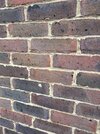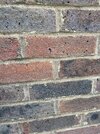Hi all,
I need to do some pointing patch repair to a few places, and trying to identify what might have been used originally.
House is ca 1950s ex-council house.
The weather-facing front (front.jpeg) has a distinctly different look-and-feel to the back of the house (back.jpeg), which is much more yellow and crumbly.
Might this just be different sand that was used?
I'm mostly trying to identify whether it looks like lime might have been involved. I don't really think so, and was therefore intending to patch with a 4:1 sand/mortar mix. Does that sound about right?
Many thanks
Martin
I need to do some pointing patch repair to a few places, and trying to identify what might have been used originally.
House is ca 1950s ex-council house.
The weather-facing front (front.jpeg) has a distinctly different look-and-feel to the back of the house (back.jpeg), which is much more yellow and crumbly.
Might this just be different sand that was used?
I'm mostly trying to identify whether it looks like lime might have been involved. I don't really think so, and was therefore intending to patch with a 4:1 sand/mortar mix. Does that sound about right?
Many thanks
Martin




